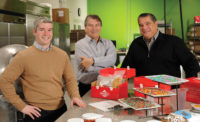
It’s known for its cleanliness, good urban design and streamlined public transportation. Influenced by a wave of European immigration in the mid-19th century, Curitiba has a diverse population base, including German, Italians, Poles and Ukrainians, and is recognized as one of Brazil’s most livable cities. Even the late Pope John Paul II visited Curitiba when he toured the country.
The thriving midsized capital city of Parana-it houses
nearly two million habitants-opened its doors of hospitality to the nation’s
largest confectionery show, Sweet Brazil, Aug. 16-19. More than 33,000 visitors
roamed 33 booths at the fair’s 13th edition, which was organized by ABICAB (the
Brazilian Association of Cacao, Chocolates, Candies and By-Products Industry)
and ABAD (the Brazilian Association of Wholesalers and Distributors).

Like many of the booths at the show. Florestal provided visitors with plenty of visual stimuli, reflecting the upbeat mood of confectionery companies in Brazil.

“We want to meet the most diverse consumer profiles with our
jellies line,” says Ricardo Heineck, Docile’s purchasing and marketing
director. “Therefore, the R&D team has spent the last 12 months researching
and developing formats, textures, flavors and colors to offer products that
could be perceived as truly innovative.
Heineck points out that Docile was the first company in
Brazil to launch yogurt candies in Brazil. Moreover, it recently invested $2.5
million in a new starch moulding line for gelatine-based products.
Fini, a company whose origins lie in Spain, now is producing
its well-known tubes in Brazil. The company also launched Princesses with Toys,
Strawberry Marshmallow, Gogo’s Dentures and a Citrus version of Mickey and its
Sleeve Pots. In addition, Joao Paulo Chaccur, Fini’s managing director in
Brazil, reveals that the parent company plans to build a new plant in the
United States in New Jersey.

Peccin, one of the biggest brands in Brazil’s sweet market,
exports to more than 70 countries. Focusing on products that stand out from the
crowd, the company launched TriBala, which uses Italian technology to allow the
chewy sweet to offer two separate flavors. The company also presented Guest, a
mini sweet. Peccin produces 3,000 tons/month and exports between 25% and 30% of
that volume.
Krafts Foods Brasil, owner of longstanding Brazilian brand
BIS, launched a new lime flavor in this famous product line. The company also
repositioned its Trident line, revamping the “formulation, packaging and
positioning,” adds Oswaldo Nardinelli Filho, the company’s sales director.
Sukest launched its FunClub Shrek line featuring a cream-filled
marshmallow as well as strawberry, lime and banana twist jelly strips. The
company remains on the cutting edge of marshmallow innovations with its Mont
Mallow line of filled marshmallows, which features chocolate, strawberry, mango
and lemon flavors. Its Fest ball product, a gumball coated with nonpareil
candies and filled with strawberry, “brigadeiro” or chocolate, tutti-frutti and
menthol flavors, continues to gain popularity. The company also debuted Spin
chewing gum, which contains tattoos with African themes. In all, it produces
about 130 products and exports 10% of its chewing gum production. Last year, it
added two new production lines to enable the launch of new innovative
marshmallow and jelly products.

More than 33,000 attendees roamed the show, which embodied the dynamism of Brazil's confectionery industry.
Having worked in the dairy products market for the last 75
years, Embaré remains one of the largest companies in Brazil and is a leader in
the caramel industry. The company posted sales of $320 million in 2009; exports
account for more than 50% of that. Projected growth has set plans in motion for
a new confectionery plant to be built within two years, says Solange Isidoro,
Embare’s export manager.
In a research study conducted by ABICAB with foreign buyers
at the fair, the association discovered that buyers, particularly Americans,
are avoiding Chinese confectionery and looking for alternatives.
Exposure to the Brazilian confectionery segment suggests
that many of the companies exhibiting at the show have the potential to step in
as major exporters. Another discovery that arose in the study was the surprise
expressed by first-time visitors to the fair over the diversity of products,
packaging, flavors and formats available in Brazil, with the majority also
stating that they found the pricing in line with the quality.
Rafael do Prado Ribeiro, ABICAB’s exports manager, says “Importers
from the U.S. who came to Sweet Brazil said that food products coming from
China are being rejected and that this should translate into an increase in the
U.S. market’s demand for Brazil’s confectionery products.”
If so, count on more foreign buyers getting a taste of Sweet
Brazil in 2011.



